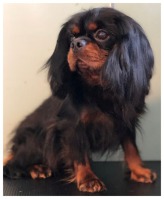To keep your puppy’s nails healthy, you need to trim them by clipping or filing them about once a month. If your puppy’s nails grow too long, they can force his foot out of position, and the nails can crack or break if they catch on something.
Methods of nail trimming
You can trim your puppy’s nails with clippers or with a file:
Clippers: clipper is ideal because it isolates the nail and steadies your cut. Ask a vet, groomer, or pet-store employee about this tool.
When clipping your puppy’s nail, you want to clip the very tip, just at the point it starts to curl. If your dog has a dewclaw (a nail that rides high on the back or front paw), don’t forget to trim it.
File: A dog file is basically just sandpaper-like material on a stick or rotating tool that files your dog’s nails rather than cuts them. Filing prevents the risk of cutting into a dog’s nail bed — a painful experience on par with cutting off the tip of your finger!
Ask a helper to pet your dog while you get familiar with using the filing tools. You should file off just the hook at the end of your dog’s nail, the same portion you’d cut with the clipper. File in five-second intervals, praising and treating your dog in between.
![Clip the nail at the tip where the point starts to curl. [Credit: Illustration by Barbara Frake]](http://media.wiley.com/Lux/08/321008.image0.jpg)
Conditioning paw-friendly handling
If you’re reading this before you’ve had to cut your dog’s nails, you can prevent problems before they begin. To avoid having a clipper-phobic dog, make paw handling part of every positive interaction, from petting to treating, by following these steps:
Initially, just handle your puppy’s paws — nothing fancy.
Occasionally throughout the day, turn to your puppy, handle his paws, and tell him “Good boy.” Have as much hand-on-paw contact as possible for a week or two. Perform no clipping at this step.
Don’t cut the nails just yet. Open and shut the clippers to acquaint him with the sound.
Try one cut — just one — by placing the edge of the clippers over the top of the nail and quickly squeezing the handle.
White nails show the nail bed, which you must avoid. If your puppy has dark nails, you need to take extra precaution. You can ask your veterinarian or groomer to give you a lesson.
The next day, try two nails and then three.
Don’t correct your dog if he protests. Be understanding and slow down. Consider the alternative, filing instead of clipping. Again, nail clipping sounds like a production, but in the long run, you’ll be glad you took the time to do it right. Anyone who has cut her dog or frightened him by being too rough can tell you that having a clipper-phobic dog is a nightmare.Take extreme care to avoid cutting into your puppy’s quick (the tissue part of the nail, shown in the figure). Aside from being excruciatingly painful, the cut will bleed for hours because the quick has lots of veins. To prevent excessive bleeding, purchase a clotting solution like styptic powder from your veterinarian. It works like magic.








